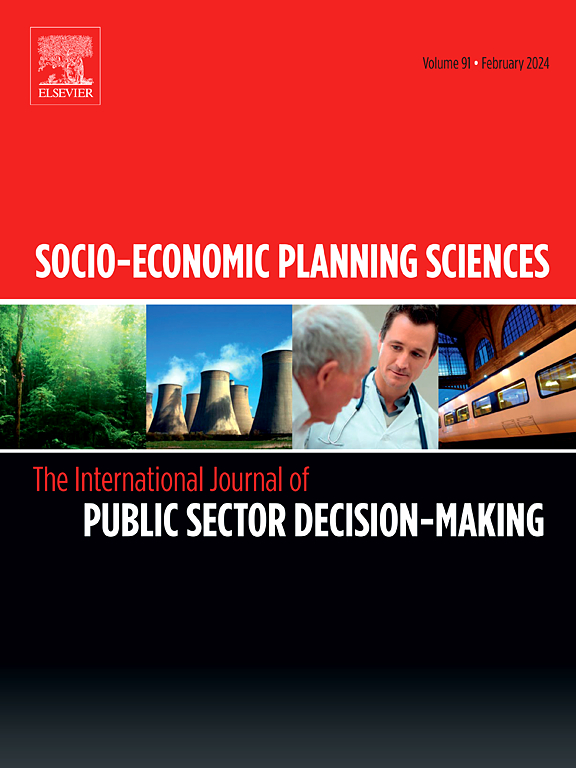A case-driven simulation-optimization model for sustainable medical logistics network
IF 5.4
2区 经济学
Q1 ECONOMICS
引用次数: 0
Abstract
The supply chain industry represents one of the largest and most critical sectors worldwide, and it is undergoing substantial transformation with the increasing integration of Electric Vehicles (EVs). In particular, EVs are being adopted within healthcare logistics networks to substantially mitigate carbon emissions and counteract escalating fuel costs, thereby enhancing the alignment of supply chain operations with broader public health and environmental sustainability objectives. This study proposes a novel Sustainable Healthcare Supply Chain Network (SHSCN) model that explicitly incorporates the deployment of EVs for the distribution of medical products and the optimal siting of Charging Stations (CSs) to support their operation. To quantitatively assess the queuing behavior of EVs at these charging facilities, an M/M/c queuing model is employed, providing insights into system performance in terms of vehicle waiting times. Additionally, the Simulation Method (SM) is utilized to estimate optimal fleet sizes and operational parameters. The validity and practical applicability of the proposed mathematical framework are demonstrated through a case study conducted within the medical industry context, employing the augmented ε-constraint method to handle the model's multi-objective nature. Given the NP-hardness of the formulated optimization problems, two novel hybrid metaheuristic approaches are introduced: Hybrid Simulated Annealing integrated with K-Medoids clustering (HKMSA), and Hybrid Tabu Search combined with K-Medoids clustering (HKMTS). Computational results indicate that both HKMSA and HKMTS exhibit superior performance relative to alternative methods, particularly in terms of solution quality and computational efficiency across problem instances of varying scales. Sensitivity analyses further reveal that a 30 % reduction in demand results in increases in all three objective function values, reaching 458,369, 894,100, and 761,790 units, respectively. Conversely, a 30 % improvement in service rate leads to a reduction in the first objective function's cost from 450,984 to 407,369 units.
案例驱动的可持续医疗物流网络仿真优化模型
供应链行业是全球规模最大、最关键的行业之一,随着电动汽车(ev)的日益融合,供应链行业正在经历重大变革。特别是,医疗物流网络正在采用电动汽车,以大幅减少碳排放并抵消不断上涨的燃料成本,从而加强供应链运营与更广泛的公共卫生和环境可持续性目标的一致性。本研究提出了一种新的可持续医疗供应链网络(SHSCN)模型,该模型明确结合了用于医疗产品分销的电动汽车的部署和支持其运营的充电站(CSs)的最佳选址。为了定量评估电动汽车在这些充电设施的排队行为,采用M/M/c排队模型,从车辆等待时间的角度了解系统性能。此外,利用仿真方法(SM)来估计最优的机队规模和运行参数。最后,以医疗行业为例,采用增强ε约束方法处理模型的多目标特性,验证了所提数学框架的有效性和实用性。考虑到公式优化问题的np -硬度,提出了两种新的混合元启发式方法:结合K-Medoids聚类的混合模拟退火(HKMSA)和结合K-Medoids聚类的混合禁忌搜索(HKMTS)。计算结果表明,相对于其他方法,HKMSA和HKMTS都表现出优越的性能,特别是在不同规模的问题实例的解决质量和计算效率方面。敏感性分析进一步显示,30%的需求减少导致所有三个目标函数值增加,分别达到458,369,894,100和761,790个单位。相反,服务率提高30%,第一个目标函数的成本从450,984个单位减少到407,369个单位。
本文章由计算机程序翻译,如有差异,请以英文原文为准。
求助全文
约1分钟内获得全文
求助全文
来源期刊

Socio-economic Planning Sciences
OPERATIONS RESEARCH & MANAGEMENT SCIENCE-
CiteScore
9.40
自引率
13.10%
发文量
294
审稿时长
58 days
期刊介绍:
Studies directed toward the more effective utilization of existing resources, e.g. mathematical programming models of health care delivery systems with relevance to more effective program design; systems analysis of fire outbreaks and its relevance to the location of fire stations; statistical analysis of the efficiency of a developing country economy or industry.
Studies relating to the interaction of various segments of society and technology, e.g. the effects of government health policies on the utilization and design of hospital facilities; the relationship between housing density and the demands on public transportation or other service facilities: patterns and implications of urban development and air or water pollution.
Studies devoted to the anticipations of and response to future needs for social, health and other human services, e.g. the relationship between industrial growth and the development of educational resources in affected areas; investigation of future demands for material and child health resources in a developing country; design of effective recycling in an urban setting.
 求助内容:
求助内容: 应助结果提醒方式:
应助结果提醒方式:


